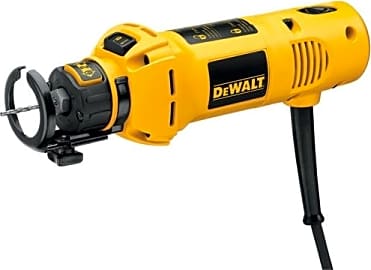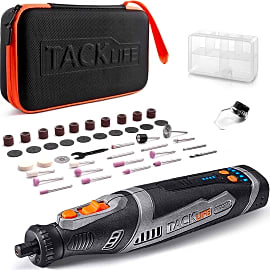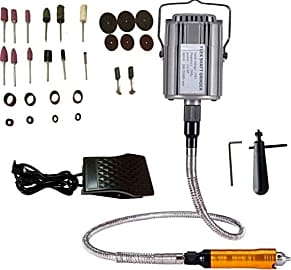The 10 Best Rotary Tools

This wiki has been updated 43 times since it was first published in June of 2015. Is there anything a rotary tool can't do? They're perfect for carving, grinding, polishing, sanding, cutting, power brushing, drilling and, well, just about anything you can think of. How effectively they can do each of these things depends on the power and quality of their motor and other components. We've ranked our selection based on ease of use, durability, and versatility. When users buy our independently chosen editorial selections, we may earn commissions to help fund the Wiki.
Editor's Notes
November 20, 2020:
We replaced the Hitachi GP10DL with its updated version, the Metabo HPT. All Hitachi products are now sold under the Metabo name, but they are made in the same factory, by the same people, and I haven’t seen anything to suggest that the quality has been affected in any way.
Since we only had three cordless models, we added the Tacklife RTD02DC, replacing the Dremel 3000. The Dremel 3000 is still a high-quality model, but we were already featuring two other Dremel models, and we felt it was worth losing to gain some more variety in our list. The Tacklife RTD02DC is nice and versatile, has a ton of accessories, and comes with a zippered storage bag. It’s also one of the cheaper options on our list, so if your budget is tight, this could be a great choice.
Rotary tools can be extremely dangerous, and safety precautions should always be followed when using them. Tool attachments or workpieces can break and send dangerous debris flying through the air, so you should always wear proper eye protection. You should also never operate your tool around flammable materials. Even just one stray spark could ignite them and cause a fire.
If you’d rather not worry about a permanent power cord getting in your way, this collection of cordless dremels should give you some more variety to choose from. Also, if these rotary tools aren’t heavy-duty enough for the projects you have in mind, an angle grinder might be a better option.
November 29, 2019:
It's hard to argue with Dremel as the top manufacturer of rotary tools, which isn't surprising given that their name has essentially become synonymous with the product category. In that light, the Dremel 4300 is understandably popular, and it also comes with a huge selection of bits. And its cordless relative, the Dremel 8220, happens to remarkably strong for a battery-powered device. The Dremel 3000, meanwhile, is one of their most maneuverable thanks to its compact construction and relatively strong motor.
They're not the only company worth considering, though. The Proxxon 38481 is exceptionally well made and should last for quite a long time -- it had better, though, because it's one of the most expensive handheld units. If you won't be using it often, the Wen 2305 is a handy and inexpensive choice, though it may not stand up to full-time operation. The Milwaukee M12 and Hitachi GP10DL are both great cordless options, and the Milwaukee has a surprisingly convenient LED light that helps you see what you're working on.
We also wanted to highlight a couple flex-shaft tools, which can be extremely useful for high-precision and full-time use because they're so much easier to control. Depending on how much you'll actually need it, the Votoer Flex Shaft and Foredom M.TX are two excellent considerations.
If you need something that packs a little more punch and can be used to slice through metal without difficulty, we'd recommend looking at a cordless or wired angle grinder or a die grinder, many of which are designed for pneumatic use.
All About Rotary Tools
It rotated a bit at high speeds for sanding, drilling, grinding, cutting, polishing, engraving, and carving.
Many people mistakenly believe that rotary tools and Dremel tools are different, but they are actually one and the same. Over time people have taken to calling nearly any type of rotary tool a Dremel tool in much the same way as any tissue is called a Kleenex. It is representative of a brand that dominated the market for so long, that the brand's name become synonymous with the product.
Rotary tools were first developed by Albert J. Dremel, who went on to found the Dremel Company in 1932. The original rotary tool was called the Dremel Moto-Tool and worked in much the same way as rotary tools today. It rotated a bit at high speeds for sanding, drilling, grinding, cutting, polishing, engraving, and carving. Many current day models are equipped with variable speed control, allowing one to better perform precision jobs. Most rotary tools spin somewhere between 3,000 and 37,000 RPM.
Since their invention, people have found a number of interesting ways to use rotary tools. During the 1940s, the Defense Department used them while creating the atomic bomb. Pedorthists have used them for making shoe inserts, dentists use them when creating dentures, and doctors have found ways to use them in dermal abrasion techniques for the removal of tattoos.
Contractors and home DIYers love rotary tools because they are the Swiss Army knife of a toolbox. They can be used to perform nearly any type of job, and they are small enough to fit in most toolboxes without adding a lot of extra weight. Rotary tools can be divided into two types: standard rotary tools and cut-out tools. Cut-out tools are designed with larger motors as they are meant to cut through heavy-duty building materials. The larger motors tends to make cut-out rotary tools larger and heavier than their standard counterparts.
Common Uses For Rotary Tools
There are dozens of attachments available for rotary tools allowing them to perform a wide range of jobs. Most people use rotary tools for fine detail work because of their small size and ease of control, but their functionality is nearly endless and they can be used on a number of jobs most never considered when purchasing their first one.
There are dozens of attachments available for rotary tools allowing them to perform a wide range of jobs.
Rotary tools excel at removing small areas of rust from metal objects. They sell wire brush attachments and other types of heads specifically designed for rust removal. Make sure to test a small, unnoticeable area first to ensure the attachment does not scratch or damage the metal underneath the rust. A rotary tool is also ideal for polishing unusually shaped objects, such as a faucet or doorknob. Some even use them to polish jewelry.
The extremely high RPM of a rotary tool make them excellent for cutting through metal and wood. They can easily be used to cut off the heads of nails that can't be pried loose, and trim off small areas of base board or molding without having to worry about over cutting. Using a very small etching attachment, a rotary tool can be used to engrave a variety of materials. They make hand engraving a relatively easy job that anybody can master with just a bit of practice.
If one does not have a drill handy, a rotary tool can be used to bore the first hole in anything from metal to wood, before continuing a plunge cut with a jigsaw. By buying a diamond bit attachment, one can also use their rotary tool to cut through glass, or make engravings on it.
What To Know Before And After Using A Rotary Tool
One of the first things to remember when using a rotary tool is to wear proper safety gear. Thick leather or rubber work gloves should be worn to protect the hands from debris and sharp edges. Safety glasses should always be worn as well. The high RPM of a rotary tool can send small particulate flying through the air, which can cause eye injury.
Thick leather or rubber work gloves should be worn to protect the hands from debris and sharp edges.
After inserting a bit, it is vital that one checks to make sure the bit is secured. If a bit is not secured, there is potential for it to fly off when in use. To test if the bit is secure, one should try wiggling it and pulling on it. If it wiggles at all, then it is not fully secure and needs to be reinserted. Only remove and insert new bits when the rotary tool is turned off and unplugged.
Those new to using rotary tools should get a feel for one by starting with the lowest speed setting and practicing on spare material. One should never try using a rotary tool for their first time on an important piece of material. You may also want to experiment with different grips to find out what works best for you.
One must use the right kind of bit for the job at hand, so it's important to understand the uses for each type. Using the wrong type of bit can damage the bit, the material, and has the potential to cause injury. The rotary tool's speed should also be set to match the specifications of the bit.















